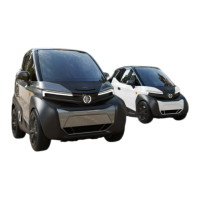If you drive with too low of a charge in
either of the traction batteries, the vehicle
could stop in the middle of trac, and
could also cause accidents and serious
injury.
• Make sure that both traction batteries are
always suciently charged!
If either of the traction batteries is not
suciently charged, gear properties
may change, e.g., the vehicle’s speed or
acceleration behaviour. If the charge is too
low, power supply may even abruptly be
reduced, and the vehicle’s speed may be
limited to 15 km/h.
• Always adapt your speed and driving
style to visibility conditions, the weather,
the road, and trac, as well as the state of
charge of the traction batteries.
WARNING
WARNING
If you leave the vehicle parked for a long
period of time with the traction batteries
uncharged, this could cause irreversible
damage to them. See good battery
charging practises >>> Page. 85.
INFORMATION
Driving modes
Fig. 32 - Driving mode indicator.
With the driving modes, you can
adapt dierent characteristics of
the vehicle’s systems to the current
driving situation and to an economical
driving style. These modes only apply
to drive (D).
To change the vehicle’s driving mode:
• Turn it on.
• To change driving mode, turn the
tip of the driving mode selection
lever forward several times.
When you change the driving mode,
the selected driving mode appears
on the instrument dashboard screen
(CITY/SPORT/ECO).
You are also informed of the
estimated distance you can travel in
the selected mode.
You may change driving mode while
driving and provided that trac
allows. To this end, rotate the tip of
the lever to select the desired mode.
Remember that deceleration may
occur when you change to more
restrictive modes, and it is possible
that you must adapt the vehicle’s
speed to activate these modes.
Fig. 33 - Selector tip.
44 Use
MU_S04 MY23_EN - USER MANUAL S04 MY23 (V002)

